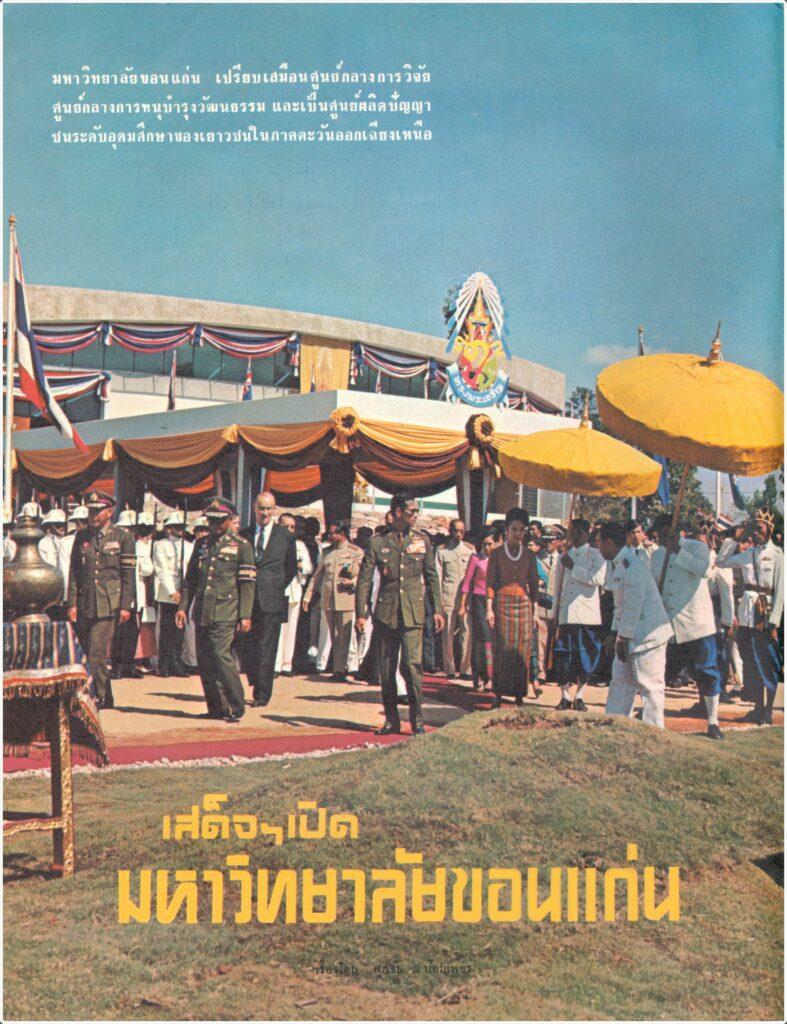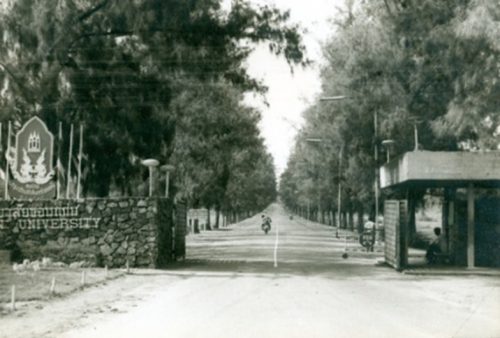History of Khon Kaen University
Khon Kaen University has developed sequentially since its establishment until now. The development can be divided into 3 eras according to the success of university administration and development.
The first era: The era of the establishment and expansion of universities
It was a relatively long period of almost two decades, from 1964 to 1983. During this period, the university was continuously established and expanded.
His Majesty King Bhumibol Adulyadej the Great's Royal Speech when he visited to open Khon Kaen University on December 20, 1967.

Khon Kaen University (KKU) is the first higher education institution in the Northeast. It was established in accordance with the policy of expanding higher education to the regions according to the first national economic development plan. The aim is to develop human resources and knowledge to solve problems in the Northeast, which is a large region with a population of one-third of the country. Every year, it has to face continuous drought and poor agricultural yields. In addition, there is a large population of poor people. His Majesty King Bhumibol Adulyadej the Great and Her Majesty the Queen presided over the official opening of Khon Kaen University on December 20, 1967, and gave a royal speech, part of which is as follows:
“The establishment of another Khon Kaen University is a great benefit because it allows higher education to be expanded to some of the most important regions of the country, which will in the future benefit the development and greatly improve the standard of living of the people in this region. The success of the establishment of Khon Kaen University is therefore an achievement that everyone should be happy about.”

• In 1962, the government of Field Marshal Sarit Thanarat as Prime Minister resolved to establish a higher education institute in engineering and agriculture in Khon Kaen Province. The institute was proposed to be called “Khon Kaen Institute of Technology” and in English “Khon Kaen Institute of Technology” abbreviated as KIT. Later, the institute’s name was changed to “Northeastern University” abbreviated as “North-East University or NEU”. Since at that time, there was no government agency that would be directly responsible for university-level education, the government resolved to assign the National Education Council to be responsible for finding a location, drafting the curriculum, and contacting foreign aid.
• In 1963, the subcommittee agreed to select Ban Si Than as the location of the university, covering an area of approximately 5,500 rai, 4 kilometers from Khon Kaen city.
• On June 9, 1964, the “Faculty of Science-Arts” building was constructed and the first batch of university students was accepted on June 24, 1964, totaling 107 people.
During the years 1964 - 1973
Khon Kaen University in its early days had 3 faculties: Faculty of Agriculture, Faculty of Engineering, and Faculty of Science and Arts (which taught basic subjects and had not yet accepted students). In the first year, a total of 107 students were accepted, and the first batch of undergraduate students in the academic year 1967 totaled 59 students. Later, the Faculty of Education (1969), Faculty of Nursing (1971), and Faculty of Medicine (1972) were established, making a total of 6 faculties during this period. In addition, the Khon Kaen University Demonstration School was established to serve as a base for teaching and learning and to provide academic services to communities outside the university.
During the years 1974 - 1983
Khon Kaen University expanded its education in the field of health sciences by establishing the Faculty of Medical Technology (1978), the Faculty of Public Health (1978), the Faculty of Dentistry (1979), the Faculty of Pharmacy (1980), the Faculty of Humanities and Social Sciences (1978), and the Graduate School (1978). In addition, there were also units to support the university’s missions, such as the Office of Academic Resources, the Research and Development Institute, and most importantly, the construction of Srinagarind Hospital. In addition to being a base for producing graduates in the field of medicine, it was also a source of medical services to people in the Northeast. During this period, there were a total of 12 faculties.
The second era: the era of development and knowledge creation
In the development of universities in each period, in addition to developing curricula to produce graduates who respond to the needs of the community and society, research is also an important duty of the university. It is research to create knowledge and provide academic services to the community and society simultaneously. The period 1984-2003 was therefore an era of development and creation of knowledge for community service, including the establishment of more curricula development agencies and the development of research capabilities.
During the years 1984 - 1993
At the beginning of this period, faculties/departments were established, namely, the Faculty of Technology (1984), the Faculty of Veterinary Medicine (1986), the Faculty of Architecture (1988), and the Faculty of Management Science (1992). In addition, the Computer Center (now renamed the Office of Information Technology), the Continuing Education Center (now renamed the Office of Academic Services), and the Queen Sirikit Heart Center, Northeast, were established. The government was also assigned to establish Ubon Ratchathani College and Suranaree College, which later separated into Ubon Ratchathani University and Suranaree University of Technology, respectively. In the third decade, the university had a total of 16 faculties.
In this era, in addition to continuously producing graduates in various fields and having many graduates go out to serve society, spread across various sectors of the country, the university has also conducted studies and research to create knowledge that can be applied to solve problems in the Northeastern region, such as developing small water sources in rural areas to solve the problem of water shortages in agriculture and developing systematic agriculture in collaboration with foreign countries, research to create knowledge for development and solving important health and disease problems in the Northeast, and has begun to conduct more research in social sciences and cultures of the region.
During the years 1994 - 2003
During this period, the university established more faculties, resulting in it becoming an important comprehensive university in the country. The Faculty of Fine and Applied Arts was established (1994), Nong Khai Campus (1997), and the Graduate School of Management (1997). In addition, more units were established to support the university’s operations, such as the Registrar’s Office (now renamed the Academic Administration and Development Office), the Mekong Institute for Economic Cooperation (now an international organization), and the Institute of Peace Studies (an agency under the supervision of the university). During this period, there were a total of 18 faculties and 1 campus.
In addition to producing bachelor degree graduates, the university also focuses on producing more graduates, with approximately two-thirds of the university’s total graduate degree programs (approximately 300 programs). It has also begun to place more importance on research by establishing specialized research centers within the university. This will be in line with the outstanding expertise of the faculty members and is seen as essential knowledge for the development of the country and the Northeast region, along with providing budget support and establishing research groups to allow new faculty members to seriously collaborate on research.
Third Era: Research Universities and Leading Research Universities
This period is an era of change from globalization, which has seen rapid advances in academics and technology. Economic and social changes have had an impact all over the world, including the country's free trade policy. In addition, Thailand has begun to reform its administrative system to be results-oriented by introducing the concept of strategic management and quality management systems into government agencies.
During 2014-2013
Khon Kaen University has changed its management system from the original to a strategic management system by adjusting the structure of the administration of the units and the administration system by setting a vision for Khon Kaen University to be a research university in creating new knowledge for the development of the community, society and the country. The university has begun to strengthen its research by establishing 15 specialized research centers. Its research has been published and referenced in both domestic and international journals. Many research works have been used to solve the main problems of the area effectively. It has also announced the mission of Khon Kaen University as ““Social Devotion” To communicate to the university community and outside to be aware of the operational direction of Khon Kaen University. At the same time, the university has also developed itself to enter into intensive quality assessment by various organizations, both government and independent external agencies, such as the Office of the Civil Service Commission (OCSC), the Office of National Education Standards and Quality Assessment (ONESQA), the Office of the Higher Education Commission (OHEC), as well as entering into international assessments from the rankings of Asia Week magazine (Asia's Best Universities 2000) and the world university rankings by Times magazine (World University Ranking 2006).
In 2009, Khon Kaen University was selected by the government to be one of the 9 “National Research Universities” with the aim of using research to solve problems in the Northeast and drive the university to reach the world level. At the same time, the Office of Academic Services was merged with the Office of Registration and Processing to form the Office of Academic Administration and Development. The Faculty of Law was established (2006), the College of Local Administration (2007), and the College of International Affairs (2008). In 2012, the Nong Khai campus was restructured to have 4 faculties: the Faculty of Business Administration, the Faculty of Integrated Social Sciences, the Faculty of Liberal Arts, and the Faculty of Applied Science and Engineering. Several other support units were also established, such as the Office of Educational Innovation, the School of General Education, the Language Institute, the Confucius Institute, the Office of Research Administration, the Office of Assessment and Quality Assurance, the Office of Coordination and Complaint Management, the Law Office, the Intellectual Property Office, and the supervised organizations, such as the Northeast Software Industry Zone Coordination Center, the Enterprise Incubation Center, the Northeast Science Park Office, the Northeast Strategy Institute, and the Kwan Mor Building. At this time, there are a total of 25 faculties.
2014 – Present
During this period, Khon Kaen University grew and its units became larger. The Faculty of Economics was established in 2015 by separating from the Faculty of Management Sciences. In addition, the name of the Faculty of Management Sciences was changed to the “Faculty of Business Administration and Accountancy”. In the same year, the university also changed its status from a government university to “State-controlled universities” On July 18, 2015, in order for the university administration to be effective and to respond to changes in external society, such as the decline in the birth rate, which results in a smaller number of children who will study, resulting in higher competition in admissions, more universities, both state universities, private universities, and foreign universities, opening up in Thailand, which is a result of the liberalization of the ASEAN Community, and the change in the new higher education admission system called TCAS, which affects the number of students admitted to the university, new curricula must be developed to integrate knowledge across disciplines more to meet the needs of new students.
From the declaration of Khon Kaen University's determination to "Dedicate to Society (Social Devotion)", the university has supported the application of research results to benefit the area, such as the Sufficiency Economy Prototype Community Project that is spread throughout the Northeast, the Kae Lawa Project, the KKU District Development Project, and the Project to Solve Public Health and Education Problems in the Northeast to Reduce Social Inequality, which are large-scale projects that integrate various fields of knowledge and have received continuous budget support from the government. It consists of the following sub-projects: the Project to Solve Liver Fluke Disease and Bile Duct Cancer in the Northeast, the Project to Develop Advanced Mathematics Thinking in Students in the Northeast, the Project to Solve Poverty Problems Based on the Sufficiency Economy Concept, the Project to Prevent and Delay Chronic Kidney Disease in the Northeast, the KKU Smart Learning Project, etc. The implementation of these projects has resulted in the quality of life of the people in the area gradually improving.
In terms of academic services to society, Khon Kaen University, through the Faculty of Medicine, has expanded the services of Srinagarind Hospital and upgraded it to be a top-notch medical center that provides comprehensive medical care for the main problems of the Northeastern region. The construction budget was received from the government in 2019 in the amount of 4.3 billion baht.
In addition to the main missions mentioned above, Khon Kaen University has developed itself to be a center of lifelong learning for society (Lifelong Learning Center) by improving the area within the university to be a learning park for society, such as the area around Bueng Si Than and the university's sports field to be a place for exercise (Sport Park) and opening up opportunities for outsiders to use the area, building a natural history museum, a science museum, and an aquarium in Nong Khai Province, preserving original forest areas and areas for studying various types of natural birds, adjusting the area to be a complete agricultural knowledge center (Agro Park) and an art and cultural park (Culture Park), etc. Currently, there are many outsiders coming to learn and join learning activities.
In terms of quality management, Khon Kaen University is currently being assessed by external agencies at the institutional, faculty and curriculum levels using national and international assessment standards, including QS Ranking, Times Higher Education and other systems.In 2018, Khon Kaen University was assessed by THE (Times Higher Education) as the number 1 university in Thailand for Social Impact, ranked 15-40 in Asia, and 101-200 in the world.
In the country, the university is assessed by many systems, including internal assessment from the Office of the Higher Education Commission (OHEC), quality assessment using the Education Criteria for Performance Excellence (EdPEx) and the National Quality Award (TQA) criteria. In 2018, Khon Kaen University was assessed by the National Productivity Institute, Ministry of Industry.Received the TQC (Thailand Quality Class) award It is the first higher education institution in Thailand to receive the National Quality Award at the university level.


